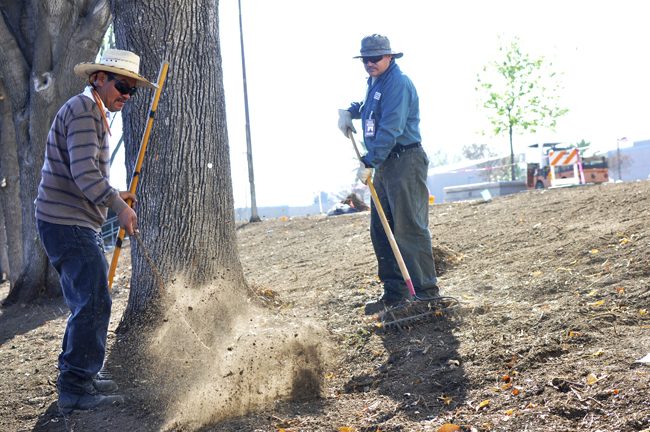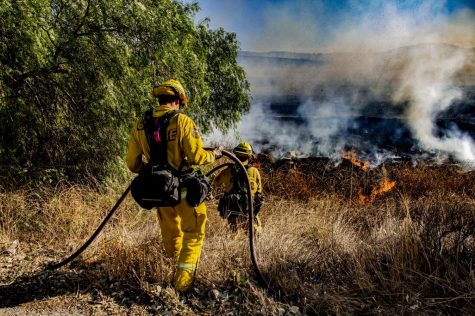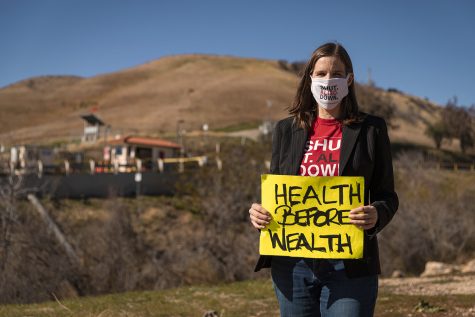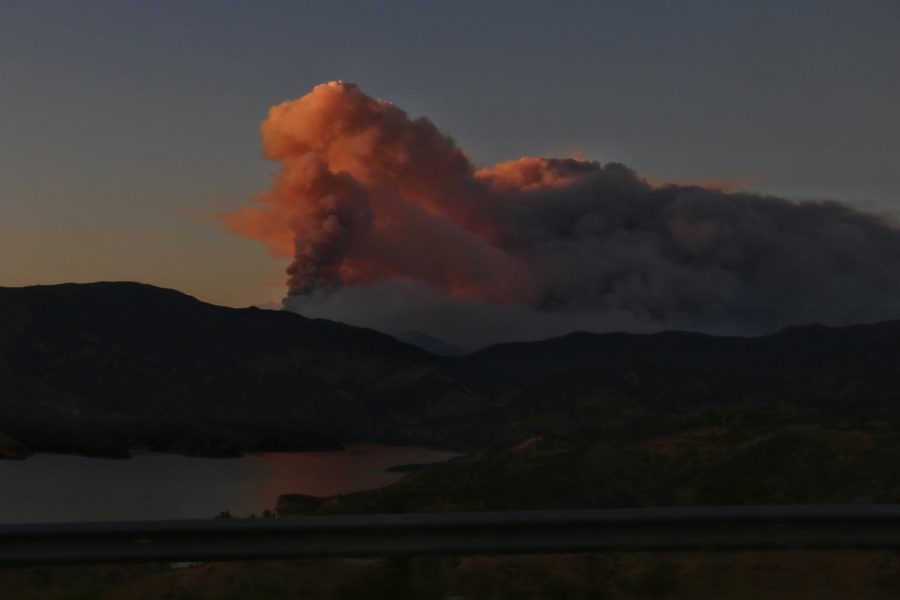California faces an uphill battle with droughts and fires. But how does climate change factor into it?
The Lake Fire has burned a roughly 10,000 acres in the Los Angeles Forest on Aug. 12.
October 18, 2021
It’s no secret California has a history of natural disasters ranging from wildfires to droughts, which have been exacerbated by climate change.
Over the last decade California has struggled through the worst droughts in its history, seemingly not improving as time goes on and the climate crisis worsens. These droughts are not the only catastrophe California faces — wildfires blaze across the state every year, burning unprecedented amounts of land.
While these natural disasters are in fact natural, the rate and severity of them are anything but, according to Georgia Tech climate scientist Kim Cobb in an Associated Press interview. “It’s going to get a lot worse,” she said.
Climate change is “the change in the usual weather found in a place,” according to NASA. This could be a change in average precipitation or temperature, which can have a little or great effect on the surrounding environment.
Climate change can be caused by many factors, but the undeniable connection between humans and the climate is evident. Mainly through combustion pollutants such as coal and oil, carbon dioxide enters the atmosphere — where it then traps heat, preventing it from leaving the atmosphere.
Drought

As the wet season came to a close, California once again fell back into a horrific drought. With three-fourths of California under extreme drought Gov. Gavin Newsom declared a drought emergency in 41 counties.
Through the process known as the greenhouse gas effect, our situation in California has only worsened. But how?
Climate change can contribute to drought in three main ways. First, increasing temperatures causes increased evaporation, drying out soil and vegetation. Last summer was the hottest and driest on record so far; to no coincidence, this spring had the lowest levels of soil moisture the western United States has seen in 120 years. Second, altered air circulation patterns are affecting how and where precipitation falls, such as the lack of 2020 southwest monsoons, which further exacerbated the drought.
The third way climate change contributes to droughts is through reduced snowpack volumes, as well as faster snowmelt from increasing temperatures and changing precipitation patterns. As defined by National Geographic, snowpack is “snow on the ground in mountainous areas that persists until the arrival of warmer weather. Melting snowpack is an important source of water for many areas.”
Without this stable snowmelt in the springtime, the Los Angeles Aqueduct, one of Los Angeles’s main sources of water, is outputting much less flow than needed. These factors have led to a devastating drought that is only getting worse. According to the U.S Drought Monitor, more than 33% of California was under “exceptional drought” conditions, which is the most severe category.
Wildfires

Wildfires, perhaps California’s oldest and most dreaded foe, are becoming exceedingly worse. Through poor forest management and record-breaking droughts, the Golden State has become a metaphorical tinderbox, putting millions of Californians and their homes at risk. Wildfires are especially no laughing matter to the residents of the San Fernando Valley, as anyone can remember the dreaded Woolsey Fire that was seared into the collective memory.
On Nov. 8, 2018, at approximately 2:24 p.m, Southern California Edison’s electrical equipment sparked one of the worst fires the San Fernando Valley had ever suffered. The Woolsey Fire eventually burned through 96,949 acres of land, destroyed 1,643 structures and killed three people.
It was only just one of many fires that ignited on that same day, yet it was the most imposing. The smoke and ash could be seen and felt as far as downtown Los Angeles, a stark reminder of the real and immediate consequences of climate change.
But how did climate change bring about such devastation?
The same way it brought about drought. Through rising temperatures, vegetation is increasingly losing moisture, becoming drier and creating the perfect tinder for a wildfire.
Mix that with poor forest management, heavy winds, a little spark — a devastating fire is inevitable.
As of early June, the state has seen a 26% increase in wildfire activity compared to 2020, as well as a 58% increase in acres burned, according to the California Department of Forestry and Fire Protection. Last year also marked the largest wildfire season on record, with more than four million acres burned.
Solutions

First and foremost, practice appropriate fire safety. Smokey Bear was serious when he said, “Only you can prevent forest fires.” It’s time to live up to that message. Put out fires appropriately and thoroughly, check fire danger reports and be extra cautious if it’s windy, and always only build fires where it is allowed and far away from dry brush.
The two main technological solutions being considered for the water crisis are desalinators and potable reuse, aka waste water recycling. These two technologies are very similar, as both take undrinkable water and purify it. Desalination can work through two methods: multistage flash and reverse osmosis.
Reverse osmosis, according to the American Chemical Society, occurs when you filter saltwater through a semipermeable membrane — a layer that only certain molecules can pass through — using pressure to move the water along. Intense amounts of pressure are exuded on the water, forcing it to pass through tiny pores smaller than a strand of hair, capturing the larger molecules such as the salt molecules.
Multistage flash on the other hand utilizes heat to convert saltwater into freshwater. According to the Organization of American States, this process is conducted by rapidly bringing the water to a boil, either multiple times or in stages. As the saltwater enters each stage of the conversion unit, it is exposed to external steam heat and pressure.
The water vapor then forms and is collected. It is from this water vapor that we get our fresh clean water.
While these technologies sound like the answer to the water crisis, it must be noted that desalination has its own problems. As Congressman Brad Sherman (D-Sherman Oaks) said, “Desalinization is very expensive, not profitable for many crops, and also adds to the carbon footprint that causes global warming.”
So what about potable reuse? Potable reuse, or waste water recycling, refers to recycled water people can drink.
Through this process, contaminated water travels through sewers and pipes to water treatment plants, where it is either cleaned to a point where it may be reintroduced into the environment or sent to a water purification facility to undergo further cleaning and filtration.
While this method is efficient and effective, it has garnered backlash and stigma from many Californians for its connection to wastewater — even being dubbed “toilet to tap.” But this stigma is unwarranted, as the process makes the water purer than water straight from the Colorado River, where minerals have to be artificially added.
These solutions offer a temporary relief to the issue, but climate change brings with it more problems than just drought.
Whether by driving or flying less, using less electricity, optimizing your diet, or purchasing from sustainable companies, one can have a massive effect on the climate for the better.
